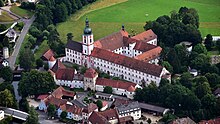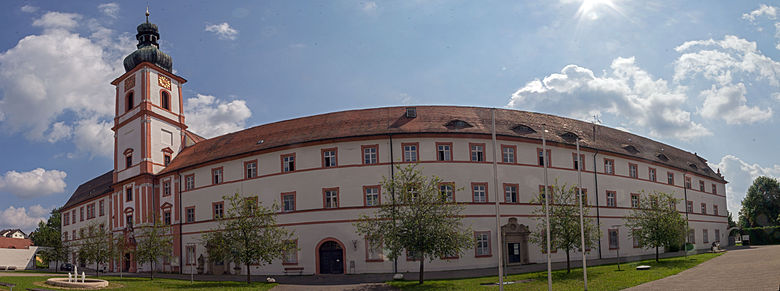Michelfeld Monastery (Upper Palatinate)
Michelfeld Monastery is a former Benedictine abbey in the Michelfeld district of the city of Auerbach in Upper Palatinate in the Archdiocese of Bamberg .
History up to the abolition of the monastery in 1556
The monastery, consecrated to St. Michael and St. Johannes Evangelist , was founded on May 6, 1119 by Bishop Otto I of Bamberg . Bishop Otto wanted to counter possible claims of Count Palatine Otto , who after the extinction of the Lords of Pettendorf-Lengenfeld-Hopfenohe, as the son-in-law of the last Pettendorfer, was able to take possession of large parts of this inheritance. The first Benedictine monks came from the Michelsberg monastery near Bamberg . At the beginning Michelfeld was a double monastery, because nuns also owned a small monastery building a few hundred meters away in Horsrach . The monastery rose to a parish in 1121, when Bishop Otto donated the Leonhard Church in Michelfeld, today a cemetery church, to the monastery. As sovereign, the bishop claimed the monastic property management and the right to appoint the abbot, which was confirmed to him by Pope Calixt II in a document dated April 3, 1123. In 1134 Otto appointed himself abbot of Michelfeld in personal union. In 1145 the abbots were given the right to wear gloves and pontifical shoes as a sign of their dignity, and Pope Innocent IV granted them the right of inful in 1247 . The market of Michelfeld was relocated to the neighboring Auerbach in 1144, over which the monastery exercised lower jurisdiction . The result was a considerable economic boom, and in 1332 the monastery was able to lend the diocese of Bamberg 600 pounds of Heller . All privileges were confirmed to the monastery by King Wenceslaus in 1385.
A great fire in 1378 caused great damage. In the Bavarian-Bohemian War (1400 - 1401) between King Ruprecht and the Bohemian King Wenzel, the decisive battle took place here, which severely affected the monastery as well as Auerbach. Under Abbot Theodoric, the monks even had to go around with begging letters and ask for alms.
The abbey suffered further damage in the Hussite Wars . The monastery is said to have burned down or at least been badly damaged as early as 1420. Also during the winter campaign of the Hussites on February 9, 1430 they camped on the Pegnitz and also heavily devastated the monastery, even though the payment of 12,000 guilders to the Hussite armies stipulated that they should spare the high estates. As a result, it was no longer possible for the livelihood of all monks to be secured and some had to be housed in neighboring monasteries. Abbot Heinrich III. von Truppach handed over the administration to two monastery administrators and went with most of the monks to the provost of Zell am Main . Prior Iban Eckard also found shelter in Weißenohe monastery and even became abbot there. Despite this tense situation, on August 1, 1436, the senior of the monastery, Walther Sweistorffer, was elected abbot, from which Hartung Pfersfelder emerged as the new abbot. On November 5, 1436, Bishop Anton , deputy commissioner at the Basel Council , confirmed the election. Under Abbot Pfersfelder, the Chancellor reform was introduced in the monastery. Under him, a new land register was created, the execution of October 6, 1439 has been preserved. It is also recorded that under Abbot Theodoric the burgrave of Nuremberg , who had taken the bailiwick of Michelfeld, attacked and robbed the monastery. The reforms introduced made it possible to raise Michelfeld economically and to restore the fortifications. Abbot Pfersfelder was entrusted with the management of the Michelsberg Abbey in Bamberg in 1450 and of the Imperial Abbey of St. Emmeram in Regensburg in 1452 . After he left Michelberg, reform efforts stagnated. During his time there was also a rapprochement with the Wittelsbach family . On June 25, 1441 , Count Palatine Johann von Neumarkt gave the monastery a donation for the transfer of the war wood in Auerbach. His son Christoph von Pfalz-Neumarkt also confirmed all of the monastery's privileges in 1444. In a royal document on October 19, 1465, Emperor Friedrich III confirmed . the Count Palatine Otto II. Michelfeld belonged to the Upper Palatinate territory . The conflict between the Diocese of Bamberg and the Count Palatine, who had, so to speak, sneakily appropriated Michelfeld, continued beyond the time of the first abolition of the monastery.
Abolition and regeneration of the monastery
In the course of the Reformation initiated by Ottheinrich , the Michelfeld Abbey was abolished under Abbot Friedrich von Aufseß in 1556. Despite the ban on accepting new members, monastic life could be maintained with four Benedictines still living in the monastery. After the death of the last abbot († March 3, 1558), the Palatinate administration took over Michelfeld. The administrative unit remained in place. This made it easier for Elector Ferdinand Maria in 1669 to restore the Koster to its previous purpose and to return it to the Benedictine order. The abbot of Oberaltaich was appointed as administrator and came to Michelfeld with four monks to rebuild the convent. On July 29, 1669, the Benedictines were reinstated in all their previous rights and in 1695 the monastery regained its independence.
The abbey church and cloister were badly affected by the turmoil of the Thirty Years' War and the Calvinist iconoclasm . Therefore the order decided to rebuild. The new monastery building and the abbey church were rebuilt between 1680 and 1700 according to plans by Johann and Wolfgang Dientzenhofer . The church is a pillared church on a rectangular floor plan. The choir is closed by a wooden vault as a Bohemian cap .
Furnishing
The church was furnished under Abbot Wolfgang Rinsweger (1707–1721) . Rinsweger had previously made his profession in the Tegernsee monastery . His coat of arms and his initials are on the organ gallery (“17 WAIM 14”: 1714 Wolfgang, Abbot of Michelfeld). He commissioned the brothers Cosmas Damian and Egid Quirin Asam with the painting and stucco work. Cosmas Damian Asam painted a. a. the adoration of the shepherds on the organ gallery (signature “CD Asam, 1717”), the suffering of Christ on the central ceiling fresco and the resurrection of Jesus . On the fresco above the main altar, the feast of Pentecost is represented, symbolized by a dove and the seven gifts of the Holy Spirit (gift of understanding, advice, wisdom, science, fear of God, piety and strength). The high altar was designed by the Asam brothers with winding " Bernini columns ". The altarpiece shows Jesus in the midst of his disciples at the Last Supper ; Maria Magdalena is on the left . According to tradition, the people in the foreground are said to be the Asam brothers and their sister Maria Salome and Giovanni Battista Carlone . The work is signed "CD Asam INV (invenit)" and was completed in 1721. The six side chapels are dedicated to St. Benedict and his sister Scholastica , the Rosary Madonna , the Mother of Sorrows, as well as St. Otto and St. Nepomuk . The paintings on the side altars were made by Otto and Johann Gebhard . The figures of the fourteen helpers in need are by Egid Quirin Asam. Lay brother Anton Denzler created the pulpit, the organ front and the choir stalls above the sacristy on the first floor.
List of some Benedictine abbots from Michelfeld
- Imbriko from Bamberg (1119 - 1121)
- Otto I of Bamberg (1134 - 1139), Bishop of Bamberg
- Adalbert I of the Paulinzella Monastery (1142 - 1155)
- Theodoric (1375-1406)
- Henry III. von Truppach (around 1430 - 1436)
- Hartung Pfersfelder (1436 - 1451), † 1458 in Bolsena
- Friedrich von Aufseß (around 1556, † March 3, 1558)
- Hieronymus Gazin was appointed administrator of the Oberalteich monastery in 1661
- Albert Stöckl (from May 1, 1700–1707)
- Wolfgang Rinsweger (1707 - 1721, † October 14, 1721)
- Heinrich Harder (1721–1738)
- Marianus Eder (1738–1783)
- Agidius Bartscherer (1783 - 1799, † November 12, 1799)
- Maximilian Prechtl (1800–1803), last dept
Michelfeld Monastery today
The monastery was placed under electoral administration on March 13, 1802 and finally abolished in 1803 in the course of secularization . The last abbot of the monastery was Maximilian Prechtl . The abbey church, richly furnished in Baroque style by the Asam brothers at the beginning of the 18th century , became a parish church.
In 1884 the Dillingen priest Johann Evangelist Wagner bought the monastery. Since 1885 a facility of the Regens Wagner Foundation has been housed in the spacious monastery complex , which looks after people with mental and physical disabilities.
literature
- Tobias Appl: Hartungs Pfersfelder erigit e rideribus Monasterium. The renovation of Michelfeld Monastery under Abbot Hartung Pfersfelder in the first half of the 15th century . In Tobias Appl; Manfred Knedlik (ed.): Upper Palatinate monastery landscape. The monasteries, monasteries and colleges of the Upper Palatinate. Pp. 64-77. Friedrich Pustet , Regensburg 2016, ISBN 978-3-7917-2759-2 .
- Luiztpold Dietl; Markus Nowak; Susanne Dietl: Michelfeld in the Upper Palatinate. Parish Church of St. Johannes Evangelist - Asamkirche, based on the records of Pastor Franz Wolfring. Catholic parish office Michelfeld 2011.
Web links
- Manfred Knedlik: Monasteries in Bavaria: Michelfeld in the Upper Palatinate - A founding of St. Otto von Bamberg. House of Bavarian History
- Rudolf Weber: Michelfeld Monastery. In: weber-rudolf.de. December 13, 2008 .
- Website of the "Regens Wagner-Werk"
Coordinates: 49 ° 42 ′ 14 " N , 11 ° 35 ′ 13.6" E





